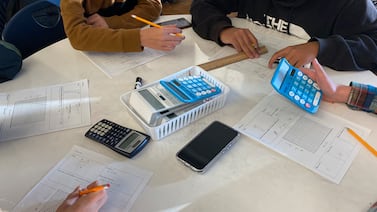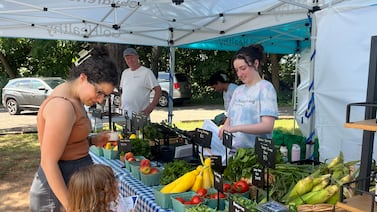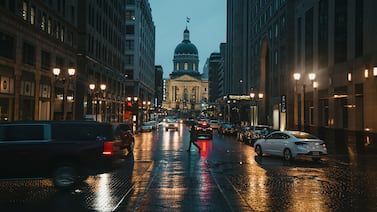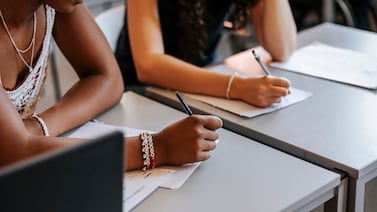Chicago will again delay reopening classrooms for more than 60,000 students as the school district and teachers union failed to meet a deadline for a deal.
Chicago Public Schools told families Wednesday evening that it would delay reopening until at least Feb. 8. The district said negotiations would continue, making Thursday a remote school day. Friday already was slated to be a day off for students.
The district also announced a second — and final — 24-hour “cooling off period” in which no additional disciplinary action would be taken against teachers who don’t return to school buildings.
“We are disappointed to report that at this time, no deal has been reached between CPS and the Chicago Teachers Union leadership,” the district announced on Twitter at nearly 10 p.m.
The announcement comes after an initial 48-hour “cooling off period” called by Chicago Public Schools to give the two sides time to reach an agreement without the threat of teacher lockouts by the district or a strike from the union. But, as of Wednesday evening, the two sides had failed to secure a deal.
A bargaining chart shared by the union showed that negotiators reached tentative agreement on who gets tested for COVID-19 and how often, with a plan to offer testing for all symptomatic students and staff, along with all employees and some students at the 134 schools in areas with the highest COVID-19 rates in the city.
But the chart showed that some of the same key issues continue to dog negotiations: how many educators will receive work-from-home accommodations, vaccination schedules, and what metrics will be used to decide when the district opens and closes schools.
The union is asking that Chicago vaccinate at least 1,500 CTU members every week, and increase that number as more doses of the vaccines become available. According to the document, the district has agreed to the number of weekly doses — but officials want them for district staff, not just union members. District officials also want to prioritize employees with accommodations, who then would be required to return to school buildings after receiving one dose. (The latest weekly vaccine allotment data showed Chicago received slightly more than 39,000 doses the week of Jan. 24.)
The district has said it will grant accommodations to all educators and support staff who themselves have medical conditions and 20% of school staff who live with a family member in a COVID-19 high risk category. The union wants to see that percentage increased — a request the district says could impact efforts to staff school buildings.
So far, the two sides have reached tentative agreements on four other key issues: contact tracing, ventilation, some health and safety protocols, such as personal protective equipment and cleaning and disinfection practices, and school-level safety committees that will provide some oversight on safety and mitigation.
Uncertainty taking a toll on families and students
Without an assurance that it will have enough staff in school buildings, Chicago has canceled in-person learning every day since the union passed a resolution instructing members to refuse to return to school buildings until they had a written agreement over reopening.
The union’s House of Delegates met on Wednesday night, but did not make any major movement, either toward setting a strike date or reviewing a tentative agreement. The union is expected to hold a meeting Friday to give an update to members.
The ongoing uncertainty has caused turmoil, and some anger, among families and students in the district who say their needs have been drowned out amid the labor dispute.
Friday, when teachers are expected to turn in second quarter grades, is important for high school students applying to colleges.
Nova Gomez, a student at Lane Tech, said students are anxiously watching the standoff between the district and the union. Students took their virtual final exams this week, and some worry about an educator strike paralyzing the district before they can get their first semester grades, which they need for college applications. Some are concerned about losing touch with teachers and counselors who are writing letters of recommendation for them.
“As a senior, I feel extremely nervous about a possible strike,” she said.
A shaky timeline
With no agreement mid-week, the question of when Chicago’s reopening plan could move forward remains up in the air.
Chicago initially reopened schools for prekindergarten and some special education students in January, but as tensions with the teachers union heated up, that attempt faltered. In protest of the plan, some teachers did not report to school buildings as directed, and the district locked out about 100 of them, curtailing access to email and key technology platforms.
After the school district said it wanted to move ahead with the next phase of its plan — which called for bringing students in kindergarten through eighth grade back to classrooms Monday — the union narrowly passed a resolution that called for all teachers and some paraprofessionals to work remotely until the union and the district reached an agreement on reopening. If the district moved to lock out additional teachers, the union said it would strike.
The ongoing standoff has not only delayed the second stage of Chicago’s reopening plan, but it could disrupt remote learning for the district’s 300,000 students should a strike unfold. Chicago currently expects to bring back some 62,000 students to in-person classes this year.
Meanwhile, a group of nine parents are threatening to sue the teachers union if educators walk out, arguing it would be an illegal work stoppage, the Intercept reported Wednesday.
As the standoff in Chicago raises questions about the safety of school reopening, two studies released by the Centers for Disease Control and Prevention last week offer new, seemingly conflicting data on schools and COVID-19 spread, giving a snapshot of the kind of data points schools have as they make decisions about reopening.





